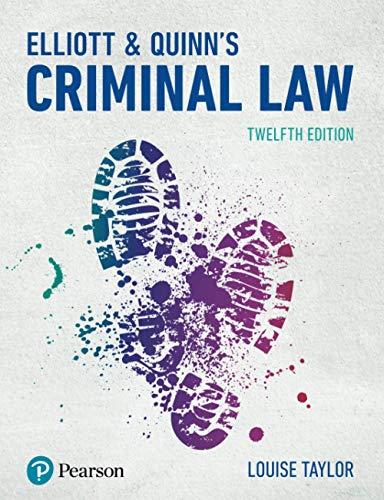Question
Review the following case study and address the questions that follow: The plaintiff, Bonita Perkins, in Perkins v. Lavin, was a Jehovah's Witness. She gave
Review the following case study and address the questions that follow:
The plaintiff, Bonita Perkins, in Perkins v. Lavin, was a Jehovah's Witness. She gave birth to a baby at the defendant's hospital. After going home, she began hemorrhaging and returned to the hospital. She specifically informed the defendant's employees that she was not to be provided any blood or blood derivatives, and she signed a form to that effect:
I request that no blood or blood derivatives be administered to [plaintiff] during this hospitalization, notwithstanding that such treatment may be deemed necessary in the opinion of the attending physician or his assistants to preserve life or promote recovery. I release the attending physician, his assistants, the hospital, and its personnel from any responsibility for any untoward results due to my refusal to permit the use of blood or its derivatives.
Because of the plaintiff's condition, it became necessary to perform an emergency dilation and curettage. She continued to bleed, and her condition deteriorated dramatically. Her blood count dropped, necessitating administration of blood products as a lifesaving measure. Her husband, who was not a Jehovah's Witness, consented to a blood transfusion, which was administered. The plaintiff recovered and filed an action against the defendant for assault and battery. The plaintiff's claim as to assault and battery was sustained.
The plaintiff specifically informed the defendant that she would consider a blood transfusion as offensive contact. Although both parties noted that the plaintiff's husband provided his consent for the transfusion, the defendant had not argued that his consent was sufficient to overcome the plaintiff's direction that she was not to receive a transfusion. The plaintiff submitted sufficient evidence to the trial court to establish that there was, at least, a genuine issue as to whether the defendant intentionally invaded her right to be free from offensive contact. Because of the plaintiff's recognition that the defendant acted to save her life, a jury may find that she is entitled to only nominal damages.
- Should the court be the ultimate decision maker when there is a dispute over whether a lifesaving measure should be administered to a nonconsenting patient? Explain.
- Should a parent have the right to refuse a lifesaving treatment (e.g., transfusion) for a minor? Explain.
Step by Step Solution
There are 3 Steps involved in it
Step: 1

Get Instant Access to Expert-Tailored Solutions
See step-by-step solutions with expert insights and AI powered tools for academic success
Step: 2

Step: 3

Ace Your Homework with AI
Get the answers you need in no time with our AI-driven, step-by-step assistance
Get Started


